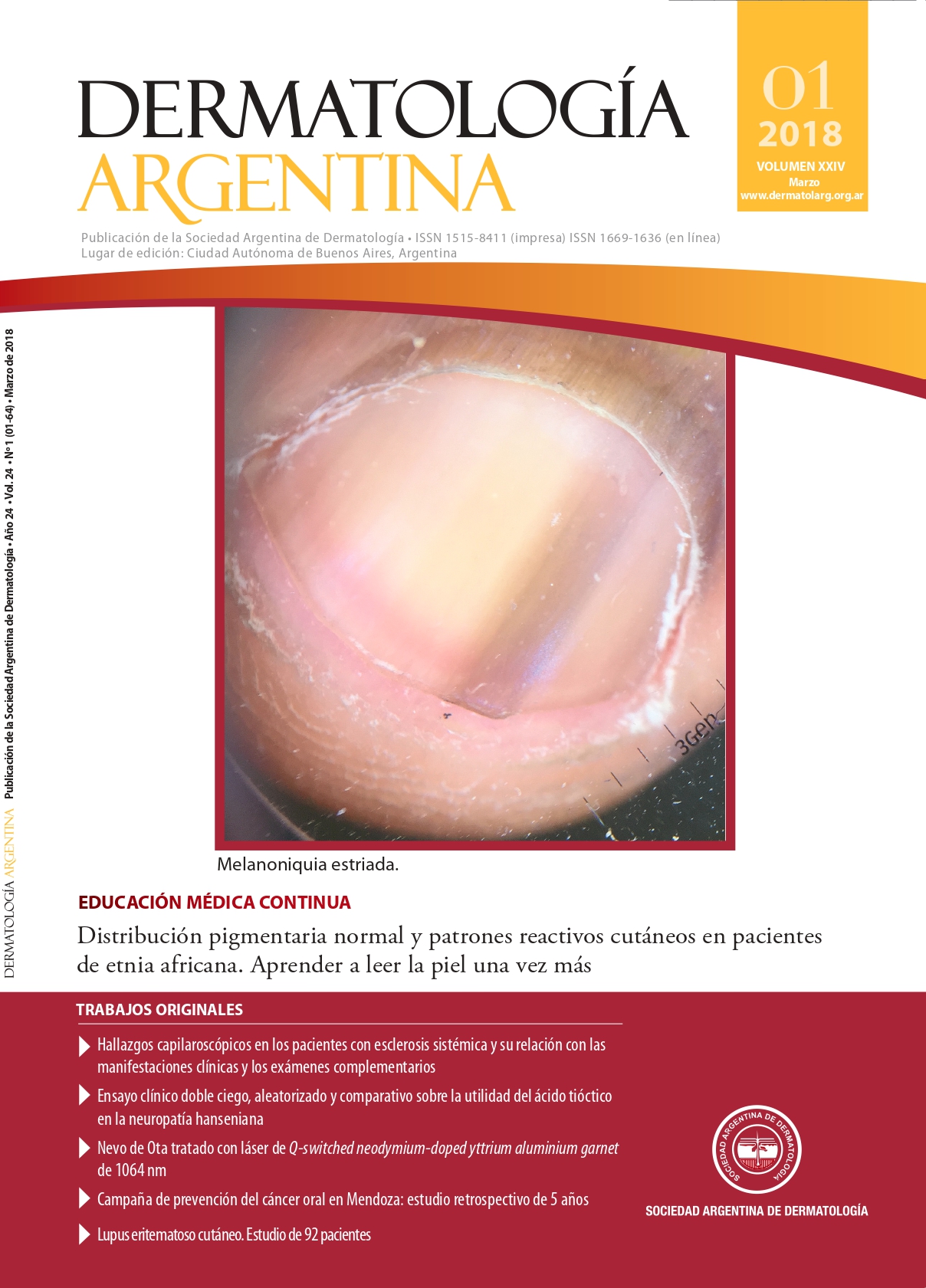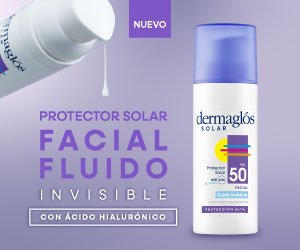Cutaneous lupus erythematosus. A study of 92 patients
Keywords:
cutaneous lupus erythematosus, ystemic lupus erythematosusAbstract
Introduction: lupus erythematosus (LE) is a chronic inflammatory autoimmune disease characterized by a wide spectrum of manifestations and a variable evolution.
Objectives: to describe in our population with diagnosis of cutaneous lupus erythematosus (CLE): age, sex, clinical forms, nonspecific cutaneous manifestations. Identify association with systemic lupus erythematosus (SLE) or other connective tissue diseases and treatments employed.
Design: retrospective descriptive study.
Materials and methods: we analyzed clinical records of patients between 16 and 68 years old from Latin America, with diagnosis of CLE treated in our dermatology department between 2007 and 2016.
Results: of 122 patients, 92 met the inclusion criteria. The mean age was 37 years, 90.2% (n = 83), female. Twenty nine percent (n = 27) had more than one type of CLE, a total of 125 lesions. The chronic form was 68.8% (n = 86) and within this, the discoid subtype was 60.4% (n = 52). The acute form was 21.6% (n=27) and the subacute form was 9.6% (n = 12).Of the 92 patients with CLE, 52.2% (n = 48) had diagnosis of SLE. Of these, 47.9% (n = 23) presented SLE before cutaneous compromise; 35.4% (n = 17) developed SLE within the first year CLE was diagnosed and 16.6% (n = 8) after. Another connective tissue disease was observed in 14 patients (no SLE).The most frequent nonspecific manifestations were photosensitivity, diffuse alopecia and Raynaud’s phenomenon.Treatment with antimalarials was the most used.
Conclusions: epidemiological studies in Argentina are rare. Most of our results agree with other series of studies. In this paper, we analyze an important number of patients, which allows us to increase the national casuistry and get closer to the reality of this pathology in our environment.
References
I. Hedrich CM. Shaping the spectrum - From autoinflammation to autoimmunity. Clin Immunol 2016;165:21-28.
II. Sánchez-Schmidt JM, Pujol-Vallverdú RM. Diagnóstico diferencial de las lesiones cutáneas en el lupus eritematoso. SeminFund Esp Reumatol 2006;7:12-26.
III. Gilliam JO, Sontheimer RD. Distinctive cutaneous subsets in the spectrum of lupus erythematosus. J Am Acad Dermatol1981;4:471-475.
IV. Grönhagen CM, Fored CM, Granath F, Nyberg F. Cutaneous lupus erythematosus and the association with systemic lupus erythematosus: a population-based cohort of 1088 patients in Sweden. Br J Dermatol 2011;164:1335-1341.
V. Lim SS, Drenkard C. Epidemiology of lupus: an update. Curr Opin Rheumatol 2015;27:427-432.
VI. Ortega S, Barbarulo A, Spelta M, Gavanzza S, et ál. Lupus eritematoso cutáneo: revisión de nuestra casuística en los últimos 15 años. Dermatol Argent 2011;17:116-122.
VII. Bolomo G, Palazzolo J. Lupus eritematoso cutáneo. Estudio retrospectivo en 47 pacientes. Dermatol Argent 2014;6:400-410.
VIII. Petri M, Orbai AM, Alarcon GS, Gordon C, et ál. Derivation and validation of the Systemic Lupus International Collaborating Clinics classification criteria for systemic lupus erythematosus. Arthritis Rheum 2012;64:2677-2686.
IX. Hochberg MC, Hochberg MC. Updating the American College of Rheumatology revised criteria for the classification of systemic lupus erythematosus. Arthritis Rheum 1997;40:1725.
X. Kuhn A, Ruzicka T. Classification of cutaneous lupus erythematosus. En: Kuhn A, Lehmann P, Ruzicka T. Cutaneous lupus erythematosus. Springer, Berlin, Heidelberg, 2005:53-57.
XI. Stringa O, Troielli P. Consenso sobre diagnóstico y tratamiento de lupus eritematoso cutáneo. Actualización 2016. Sociedad Argentina de Dermatología 2016;1-62.
XII. Biazar C, Sigges J, Patsinakidis N, Ruland V, et ál. Cutaneous lupus erythematosus: first multicenter database analysis of 1002 patients from the European Society of Cutaneous Lupus Erythematosus (EUSCLE). Autoimmun Rev ElsevierBV2013;12:444-454.
XIII. Avilés Izquierdo JA, Cano Martínez N, Lázaro Ochaita P. Epidemiological characteristics of patients with cutaneous lupus erythematosus. Actas Dermosifiliogr AEDV 2014;105:69-73.
XIV. Sánchez J, Pujol Vallverdú R. Diagnóstico diferencial de las lesiones cutáneas en el lupus eritematoso. Semin Fund EspReumatol 2006;7:12-26.
XV. Rodríguez-Caruncho C, Bielsa I, Fernández Figueras MT, Roca J, et ál. Lupus erythematosus tumidus: a clinical and histological study of 25 cases. Lupus 2015;24:751-755.
XVI. Rodríguez-Caruncho C, Bielsa I. Lupus erythematosus tumidus: a clinical entity still being defined. Actas Dermosifiliogr2011;102:668-674.
XVII. Durosaro O, Davis MD, Reed KB, Rohlinger AL. Incidence of cutaneous lupus erythematosus, 1965-2005: a population-based study. Arch Dermatol 2009;145:249-253.
XVIII. Hassan ML. Lupus eritematoso. En: Hassan ML. Colagenopatías en dermatología con enfoque multidisciplinario. Akadia, CABA, 2017:103-178.
XIX. Werth VP. Clinical manifestations of cutaneous lupus erythematosus. Autoimmun Rev 2005;4:296-302.
XX. Okon LG, Werth VP. Cutaneous lupus erythematosus: diagnosis and treatment. Best Pract Res Clin Rheumatol 2013;27:391-404.
XXI. Kuhn A, Aberer E, Bata Csörgő Z, Caproni M, et ál. S2k guideline for treatment of cutaneous lupus erythematosus–guided by the European Dermatology Forum (EDF) in cooperation with the European Academy of Dermatology and Venereology (EADV). J Eur Acad Dermatol Venereol 2017;31:389-404.
XXII. Kuhn A, Ruland V, Bonsmann G. Cutaneous lupus erythematosus: Update of therapeutic options: part II. J Am AcadDermatol 2011;65:195-213.
Downloads
Published
Issue
Section
License
Copyright (c) 2018 Argentine Society of Dermatology

This work is licensed under a Creative Commons Attribution-NonCommercial-NoDerivatives 4.0 International License.
El/los autor/es tranfieren todos los derechos de autor del manuscrito arriba mencionado a Dermatología Argentina en el caso de que el trabajo sea publicado. El/los autor/es declaran que el artículo es original, que no infringe ningún derecho de propiedad intelectual u otros derechos de terceros, que no se encuentra bajo consideración de otra revista y que no ha sido previamente publicado.
Le solicitamos haga click aquí para imprimir, firmar y enviar por correo postal la transferencia de los derechos de autor













